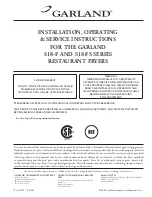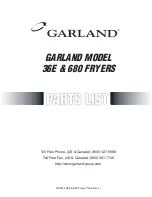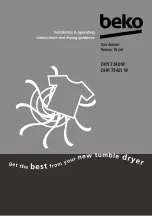
6 - INSTRUCTIONS FOR USE
505_03
- ELECTRIC FRYER
13
· 16
11/2006
• contact with non-ferrous metals (element build up)
• lack of oxygen (i.e. no air inlet, water lacking oxygen).
6.4.2 Warnings and advice for maintenance of stainless
steel appliances
• Stainless steel equipment surfaces must be kept clean and in con-
tact with air at all times. When not running, keep appliance
doors open so as to allow air to run through it.
• Regularly remove calcium , grease, starch, and egg white deposits
where rust may build up if there is lack of air. Do not use bleach-
ing products or products containing chloride. Follow all indica-
tions given by the company concerning special soaps and clean-
ing methods to be used for the appliance. If no specific cleaning
recommendations are available, it is necessary, however, to use
detergents having a low chloride content. After cleaning, remove
all soap residues with plenty of clean water and thoroughly dry
the surfaces.
• Minimize contact of stainless steel with concentrated acids,
spices, salts, etc. Even acid vapours coming from cleaning the tiles
favour stainless steel corrosion.
• Particularly for pots and multiple appliances, it is not recom-
mended to load the cooking chamber only with food having a
high salt content.
It is preferable to cook different food together, i.e. fatty dishes
or vegetables containing acids.
• Avoid damaging the stainless steel surface, in particular with dif-
ferent metals. Residues from other metals help build up the for-
mation of chemical microelements that may cause rust. At any
rate, it is appropriate to avoid contact between iron and steel
since it produces rust. Any contact between stainless steel and
iron (steel wool, pipeline chips, chalybeate waters) can start cor-
rosion phenomena.
As for mechanical cleaning, it is recommended to use only steel
wool or natural, plastic or steel bristle brushes. Steel wool or
brushes with stainless steel can cause rust due to rubbing. Newly
formed rust spots can be removed with slightly abrasive liquid
soaps or fine-grained sand paper. Larger rust spots can be removed
with 2-3% of hot oxalic acid solution. If these cleaning products do
not do the job, a nitric acid (10%) treatment is required.
Attention! These treatments can be carried out only by
expert personnel according to current regulations.
6.4.3 The 2002/96/EC (WEEE) Directive:
information to users
This informational note is meant only for
owners of equipment marked with the
symbol shown in fig. A on the adhesive
label featuring the technical specifica-
tions applied on the actual product (the
label also giving the serial number).
This symbol indicates that the product is classified, according to the
regulations in force, as an item of electrical and electronic equipment
and conforms to EU Directive 2002/96/EC (WEEE) meaning that, at the
end of its service life, it must be treated separately from domestic
waste, i.e. it must be handed in free of charge to a separate waste
electrical and electronic equipment collection centre or returned to
the reseller when buying a new equivalent item of equipment.
The user is responsible for delivering the unit at the end of its life to
the appropriate collection facilities. Failure to do so shall result in the
user being subject to the penalties prescribed by the legislation in
force on waste.
Suitable separated collection so that the unit no longer used can be
sent off for environmentally compatible recycling, treatment and
disposal helps avoid possible negative effects on the environment and
on health and facilitates the recycling of the product's component
materials.
For more detailed information on available collection systems, contact
the local waste disposal service or the shop you purchased the unit
from.
Producers and importers fulfil their responsibility for environmentally
compatible recycling, treatment and disposal both directly and by joi-
ning a collective scheme.
Fig. A


































